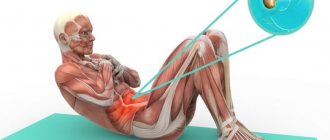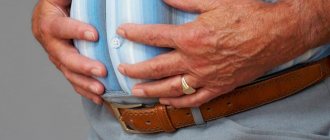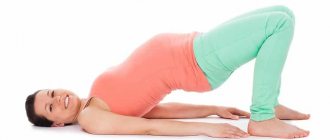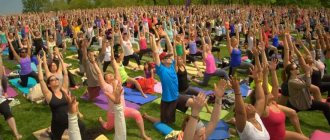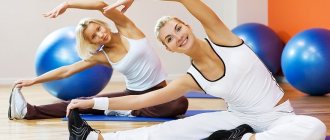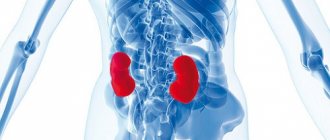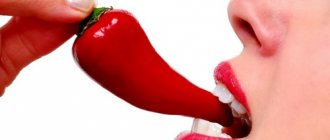The need for feasible loads
Gastroesophageal reflux disease (GERD) is the backflow of semi-digested food and gastric juice into the esophagus. This is due to improper functioning of the esophageal sphincters.
Such a common symptom as heartburn is experienced by about half of the total population of developed countries. The disease is characterized by discomfort, belching, a burning sensation behind the sternum, right up to the oropharynx. This is a symptom complex of GERD.
Why exercise is needed
Constant irritation from gastric contents causes inflammation of the esophagus. Usually during this period the patient already suffers from gastritis or ulcers, so serious drug treatment is required. To reduce the amount of medications taken, various exercises are additionally used for esophagitis.
Physical exercise alone, of course, is not enough, but special training speeds up the recovery process and reduces the number of relapses. This is an excellent prevention during remission. There is no need to constantly use medications - it is enough to maintain a healthy lifestyle and adhere to a diet.
Features of exercises for GERD
Physically active people are less bothered by disease symptoms than those who lead a passive lifestyle. This is especially true for overweight patients. They visit a gastroenterologist twice as often as people with a body mass index of no more than 25 units (normal).
When choosing the type of exercise, you should take into account the nature and degree of load and draw up an individual training plan.
Strong regular exercise eases the course of the disease, reduces symptoms, strengthens and heals a person. There are some rules that need to be considered before training:
- classes are carried out on an empty stomach;
- You can exercise 2 hours after eating;
- strictly adhere to the correspondence between food intake and training schedule;
- before classes, you should not eat foods that can cause heartburn and belching;
- Snacks are prohibited; you can eat an hour after training.
It is necessary to control the water balance, liquid is essential to stimulate digestion. Drinking a glass of water before meals reduces the concentration of gastric juice, which prevents heartburn from irritating the esophagus. And you shouldn’t drink immediately before class.
Contraindications
Reflux disease requires planning a training complex taking into account the patient’s preparation and the stage of his illness. The complex is performed standing, or at least sitting, so sports for esophagitis require a special approach. For exercise, it is better to choose yoga asanas or slow easy running. The patient may benefit from a bicycle (exercise bike), skates, or a stepper.
Significant loads performed lying down should be excluded, therefore Pilates, push-ups, bending forward are not recommended for patients with reflux esophagitis, and it is forbidden to pump the press. Weightlifting patients should limit the weight they typically lift. If training does not lead to noticeable improvement, it should be stopped, completed a full course of medication, and then resumed.
Basic exercises
Treatment of the disease requires a lot of effort, time and money. Medications eliminate heartburn, but insufficiency of the esophageal muscles and sphincter weakness persist. Gymnastics for reflux esophagitis strengthens the diaphragm and stimulates the work of the sphincters.
Healing Breath
The classes are aimed at returning to the kind of breathing that is typical for small children. Babies breathe through their stomachs, but this feature is lost with age. To master this type of breathing again, you should do 20–30 movements, and repeat the exercise after a two-minute break:
- Breathing is performed on your back with your legs bent. One hand should be placed on the chest, the other on the abdominal area. Breathe slowly through your nose. It is important that the chest remains at rest, and the stomach should rise when inhaling and fall when exhaling. If the gastric cardia is insufficient, the exercise is repeated 3-4 times, two approaches throughout the day.
- You can “breathe” while sitting with your hands on your knees; the principle of movement is the same. Inhale - the stomach protrudes and tenses, exhale - the stomach retracts. The repetition rate is 20–30 times.
- In the next exercise, inhalation is done through the mouth, through a narrow slit, and exhaled through the “lips with a tube.” For one inhalation there are 10–15 abrupt, very short exhalations, gradually drawing in the stomach.
The next exercises are performed with breath holding and load. They do it like this:
- The duration of inhalation is 4–5 seconds, the breath is held for 2–3 seconds, the duration of exhalation is 8–10 seconds. When inhaling, the stomach inflates, exhaling through one nostril. You should take 20 to 30 breaths, each time closing the right or left nostril.
- The usual inhalation is through the nose, and exhalation is done through a cocktail straw, lowering it into a vessel with water.
When the patient has mastered delayed breathing (this usually takes 3–4 weeks), breathing exercises for reflux esophagitis based on the Strelnikova method are recommended. This method was developed to restore lost voice, but remains effective in treating pathologies of other organs. The essence of gymnastics is short breaths through the nose and one noisy, drawn-out exhalation through the mouth.
You need to inhale at least 20 times. The stomach works; the chest should not rise when breathing. As you inhale, you can cross your arms over your shoulders. The exercise is performed lying, sitting, standing or in a half-squat. At the same time, turn the body or head to the sides. The number of breathing movements gradually increases. After a week of classes, the norm should be about a thousand.
How to strengthen the sphincter between the stomach and esophagus
Exercises for reflux esophagitis are selected individually. It is advisable to attend several training sessions with a certified instructor. This approach will help avoid injuries during exercise.
Exercises
Physical exercises for esophagitis are performed under the supervision of an instructor. It is important to do gymnastics on an empty stomach.
Gymnastics complex for GERD:
- Sitting on the floor, lean forward and bend your knees. Exhaling, press your fingers on the subcostal area. With each exhalation, plunge your fingers deeper and deeper.
- Standing straight with a straight back, bend to the right and left, sliding your hands on your hips.
- Lying on your back, bend your knees. Reach your elbow to the opposite knee and vice versa.
- To strengthen the lower sphincter, you need to lie on your right side on an inclined surface and raise your left leg at an angle of 45°. Repeat on the opposite side.
- Standing straight, perform sharp circular movements with your arms. Swings develop the upper shoulder girdle well and also create negative pressure in the pleural cavity.
Breathing breaks are 1-3 minutes. The complex must be repeated 2-3 times. Focus on your well-being.
Aerobics for GERD
Dynamic movements with body displacement in the vertical plane are contraindicated in patients with GERD. The best choice for cardio exercise would be an exercise bike.
During exercise on an exercise bike, the heartbeat and breathing increase, the organs are saturated with oxygen, and the activity of oxidative processes is inhibited. Improvements in esophageal motility are observed after 2-3 workouts.
In cases of severe symptoms of gastroesophageal reflux, aerobic exercise is contraindicated. This measure is necessary to prevent peptic esophagitis.
Breathing exercises
Breathing exercises for reflux esophagitis - optimal physical activity. But it must be done correctly.
Before starting classes, you should warm up. The lungs take an active part in this complex, so it is necessary to do 5-7 complete acts of breathing. Deep breathing straightens all the alveoli, forcing the lungs to work at full capacity.
Respiratory complex against esophagitis:
- Lie on your right side. Rest your head on your arm, bent at the elbow joint. Take a deep breath, then exhale with maximum force. Repeat 10-12 times. Repeat the cycle on the opposite side.
- Get on your knees. At the height of inhalation, bend the spine. Exhale. Repeat 8-10 times.
- Lie on your back. As you inhale as much as possible, rotate your pelvis. Make 10 turns on each side.
You should do breathing exercises regularly, not skip a day, always on an empty stomach and not forgetting the warm-up.
Gymnastics Strelnikova
All exercises from the complex are performed at the height of inspiration:
- Stand up straight. Place your arms bent at the elbows to the sides. Palms face forward. Clench your palms into a fist. Exhale freely, hands are relaxed.
- Standing straight, hands at waist level, fists clenched into fists. “Throw” your arms downwards, straightening your fist.
- Round your back, arms hanging freely. When bending over, bend your spine in the thoracic region.
- Feet shoulder-width apart, hands at waist level. Make a turn to the side, squatting a little. At every turn, clench your palms into fists.
- Feet shoulder-width apart, arms folded on the chest. Give yourself a quick hug and relax.
- Combine No. 3 and No. 5.
- Turns the head to the sides.
- Tilts of the head to the sides.
- Bends the torso forward and backward.
- One foot forward, the other back. Shift your body weight to the front and rear limbs alternately.
- Alternately bend your knees with an upward movement.
- Repeat No. 11, only with the leg thrown back. Try to touch your buttock with your foot.
Benefits of physical therapy
The physical therapy complex is selected individually by the instructor. Excessive dynamism, bending, weighting, and abdominal swings are eliminated. During the period of stable remission, you can use aerobics, swimming is useful.
All exercises should be free and easy, performed at a slow pace. Loads can be increased gradually and very carefully. It is important to remember: you do not need to train the muscles of the back or limbs, you need to stimulate the function of the internal organs. You should not play sports if the disease is severe.
Aerobic training
The first classes should be carried out under the supervision of an experienced exercise therapy trainer. More active physical exercise is allowed. The main goal of training is to strengthen the diaphragm.
As aerobic exercise, patients are offered brisk walking for an hour. For jogging, it is enough to allocate 20 minutes. Nordic walking, cycling, exercises on parallel bars and horizontal bars are useful.
Loads should not lead to discomfort and fatigue. You need to exercise twice a week.
Yoga
This type of training also benefits the internal organs, especially static asanas. From the complex you can use asanas for breathing and stretching. Exercises are combined with light physical activity.
Yoga improves blood circulation, speeds up metabolism, and increases muscle tone, but exercises that require inversions are prohibited for GERD.
Perfectly executed movements will strengthen the diaphragm, esophageal ligaments and abdominal muscles. Since exercise requires proper breathing, the respiratory center in the brain is activated, and organ cells are saturated with oxygen.
Massage
Self-massage of the abdominal wall has a good effect. It is performed with extreme caution, only on an empty stomach, without pressure or excessive force.
In a lying position with your legs bent, you should find a point in the abdomen, approximately 5 cm above and to the right of the navel. The area is massaged with your fingers in a circular motion, clockwise. The massage is done while exhaling and holding your breath for 6–8 seconds. When inhaling, the stomach is inflated and the massage pressure is reduced.
Massage can be combined with proper breathing.
If possible, it is better to entrust the procedure to an experienced massage therapist. You should not create a set of exercises on your own; you need to visit a specialist who understands the specific effects on the body during illness. GERD can periodically worsen, in which case physical exercise should become a method of prevention.
Healthy lifestyle with GERD
Gastroenterologists, when communicating with patients suffering from reflux esophagitis, pay special attention to lifestyle changes. Many patients are perplexed: can certain clothes, an evening walk, or a work schedule adjusted in accordance with the new condition really help?! Well, perhaps this seems funny or, at least, frivolous, however, only in this way, and in no other way, can such a problem be dealt with.
What changes should you prepare for?
- First, stop aimlessly lying on the couch with a laptop on your beer belly and a hot dog in your hand. Ideally, it would be nice to get rid of all these items at once, but, at worst, you will have to limit yourself to only food. You should have only easily digestible healthy food on your plate that does not irritate the mucous membrane of the digestive tract. After eating, do not rush to lie down for long hours, switching TV channels - take a half-hour walk (at a calm, slow pace) along a park alley or just along a quiet street.
- Secondly, after eating, do not rush to rearrange the cabinets and look for a new place for the piano. You can lift weights and engage in significant physical activity only after an hour and a half rest, even if you only ate half a banana before that.
- Thirdly, learn to eat slowly and thoughtfully, chewing food until liquid and under no circumstances swallowing large pieces. Try to plan your day so that you have time for five or six meals a day.
The disease will recede if you find the strength to say goodbye to smoking and extra pounds.
You should pay great attention to your clothes: they must be spacious, made only from natural fabrics, and not restrict movement. And, of course, no belts!
And, of course, strengthen your nervous system. Learn to think positively and find positive aspects in any event, even the saddest one. Do you think this is unrealistic? Read the wonderful novel “Pollyanna” by American writer Elinor Porter. Perhaps it will help you reconsider your outlook on life.
